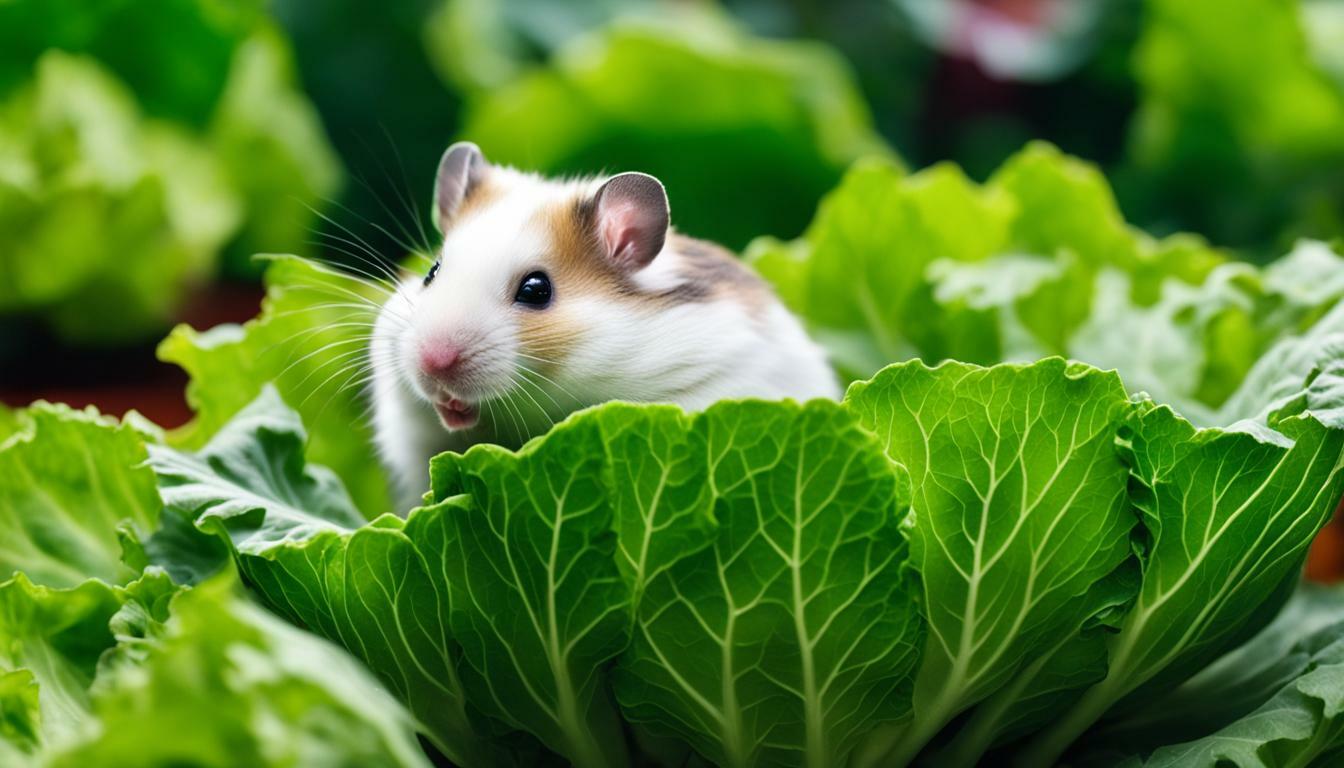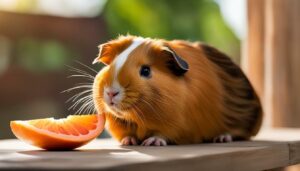If you’re wondering whether hamsters can eat cabbage, you’ve come to the right place. Cabbage is packed with nutrients like vitamins C and K, calcium, and fiber, making it a potentially healthy addition to a hamster’s diet. However, it’s important to feed cabbage in small amounts to avoid health issues such as kidney stones, digestive problems, and dehydration. When introducing cabbage to your hamster, start with small pieces and monitor for any adverse reactions.
It’s also essential to feed your hamster organic cabbage to avoid harmful chemicals that may be present in conventional varieties. While cabbage can be given to hamsters as a treat, it should not replace their main meals. To provide a varied diet, consider including other healthy alternatives like carrots, spinach, and bell peppers.
Key Takeaways:
- Hamsters can eat cabbage, but it should be given in small amounts.
- Cabbage is packed with nutrients, including vitamins C and K, calcium, and fiber.
- Feeding hamsters too much cabbage can lead to health issues like kidney stones, digestive problems, and dehydration.
- When introducing cabbage to a hamster’s diet, start with small pieces and monitor for adverse reactions.
- Feed your hamster organic cabbage to avoid harmful chemicals present in conventional varieties.
Hamster Dietary Needs
Before we dive into the specifics of feeding cabbage to hamsters, it’s crucial to understand their dietary requirements. Hamsters are omnivores and they require a balanced diet to stay healthy. Their diet should consist of a combination of fresh fruits, vegetables, grains, and high-quality hamster pellets. A good rule of thumb is to feed them a variety of foods to ensure they receive all the necessary nutrients.
It’s important to note that hamsters have specific dietary needs that must be met to prevent health issues. They require a diet that is low in fat and sugar to avoid obesity and diabetes. Additionally, hamsters have sensitive digestive systems, so it’s vital to introduce new foods gradually to avoid upset stomachs.
Hamsters also have a high water requirement, so it’s important to always provide them with fresh, clean water. Water bottles with sipper tubes are a popular choice for hamsters, as they help prevent spillage and contamination. Keep an eye on their water intake and refill the bottle regularly to ensure they stay hydrated.
| Hamster Dietary Needs | Guidelines |
|---|---|
| Protein | Provide 16-18% of their daily diet with high-quality hamster pellets or a variety of lean meats, such as cooked chicken or turkey. |
| Fruits and Vegetables | Offer a wide range of fresh fruits and vegetables, such as carrots, apples, and leafy greens. These should make up around 15-20% of their diet. |
| Grains and Seeds | Incorporate grains and seeds, like whole grains, oats, and sunflower seeds, into their diet. This should make up around 10% of their daily food intake. |
By understanding and meeting the dietary needs of your hamster, you can ensure they lead a happy and healthy life. Now, let’s explore whether it is safe for hamsters to eat cabbage and the nutritional value it provides.
Nutritional Value of Cabbage
Cabbage, like many leafy greens, offers several nutritional benefits for hamsters. It is rich in essential vitamins and minerals, making it a healthy addition to their diet. One of the key nutrients found in cabbage is vitamin C, which helps boost the immune system and supports overall health. Additionally, cabbage contains vitamin K, which is important for blood clotting and bone health.
In terms of minerals, cabbage is a good source of calcium, which is essential for strong bones and teeth. It also provides fiber, which aids in digestion and helps prevent constipation. The high water content of cabbage helps keep hamsters hydrated, especially during hot weather.
Nutrients in Cabbage
To give you a clearer picture, here is a breakdown of the key nutrients found in cabbage:
| Nutrient | Amount per 100g |
|---|---|
| Vitamin C | 36.6mg |
| Vitamin K | 76μg |
| Calcium | 40mg |
| Fiber | 2.5g |
| Water | 92.2g |
When introducing cabbage to your hamster’s diet, it is important to start with small pieces. This allows their digestive system to adjust to the new food. Monitor your hamster for any adverse reactions, such as diarrhea or bloating, which may indicate that cabbage does not agree with their system.
It’s worth noting that cabbage should be fed to hamsters as a treat rather than a main meal. Too much cabbage can lead to health issues, including kidney stones and digestive problems. To ensure the safety and quality of the cabbage, opt for organic varieties. This helps avoid harmful chemicals that may be present in non-organic cabbage.
Finally, if you’re looking for healthy alternatives to cabbage for your hamster’s diet, consider vegetables like carrots, spinach, and bell peppers. These vegetables offer similar nutritional benefits and can provide variety in their diet.
Feeding Cabbage to Hamsters
If you’re considering adding cabbage to your hamster’s diet, it’s important to do so in a controlled and cautious manner. While cabbage can be a nutritious addition to their meals, feeding too much can lead to health issues. It’s crucial to strike a balance and provide appropriate portions to ensure your hamster’s well-being.
Start by introducing small pieces of cabbage to your hamster’s diet. This allows them to adjust to the new food gradually. Keep a close eye on their reaction and monitor for any signs of digestive problems or discomfort. If your hamster shows any adverse reactions, such as diarrhea or bloating, it’s best to discontinue feeding cabbage and consult a veterinarian.
When offering cabbage, it’s essential to opt for organic varieties to avoid exposing your hamster to harmful chemicals or pesticides. Additionally, remember that cabbage should be given as a treat rather than a main meal. Incorporate it into a well-balanced diet that includes other healthy vegetables such as carrots, spinach, and bell peppers. Variety is key to providing your hamster with the necessary nutrients.
| Cabbage Feeding Tips for Hamsters: |
|---|
| Start with small pieces of cabbage |
| Monitor for any adverse reactions |
| Feed organic cabbage to avoid harmful chemicals |
| Offer cabbage as a treat, not a main meal |
| Include a variety of other vegetables in their diet |
By following these guidelines, you can safely incorporate cabbage into your hamster’s diet. Remember to always prioritize your pet’s well-being and consult a veterinarian if you have any concerns or questions regarding their nutritional needs. With proper care and moderation, cabbage can be a healthy and enjoyable addition to your furry friend’s mealtime.
Alternatives to Cabbage
While cabbage can be a nutritious addition to a hamster’s diet, there are also other vegetables that offer similar benefits. It’s important to provide a variety of safe foods for your hamster to ensure a well-rounded and balanced diet. Here are some healthy alternatives to cabbage that you can consider:
| Vegetable | Nutritional Benefits |
|---|---|
| Carrots | Rich in vitamin A and fiber, carrots promote good vision and help maintain a healthy digestive system. |
| Spinach | Packed with iron, calcium, and vitamin C, spinach supports overall bone health and strengthens the immune system. |
| Bell Peppers | High in vitamin C and filled with antioxidants, bell peppers contribute to a hamster’s overall well-being and help boost their immune system. |
When offering these vegetables to your hamster, it’s essential to wash them thoroughly and cut them into small, manageable pieces. Remember to introduce new foods gradually and observe your hamster for any adverse reactions. It’s recommended to consult with a veterinarian to ensure you are providing a safe and balanced diet for your furry friend.
By incorporating a variety of safe vegetables into your hamster’s diet, you can provide them with the necessary nutrients and help promote their overall health and well-being. Remember to always prioritize their safety and monitor their food intake to ensure they remain happy and healthy.
Monitoring Cabbage Consumption
As with any new food, it’s essential to keep a close eye on your hamster’s reaction to cabbage. While cabbage can provide valuable nutrients, overfeeding can lead to health issues. Begin by introducing small pieces of cabbage into your hamster’s diet and observe any adverse reactions. Watch for signs of digestive problems, such as diarrhea or bloating.
Signs of Overfeeding
It’s important to note that hamsters have delicate digestive systems, and introducing new foods too quickly or in large quantities can lead to problems. Keep an eye out for any changes in your hamster’s behavior or appearance. If you notice your hamster becoming lethargic, experiencing weight loss, or showing signs of dehydration, it may be a result of consuming too much cabbage.
In addition to monitoring your hamster’s physical well-being, observe their water intake. Hamsters that consume excessive amounts of cabbage may become dehydrated due to its high water content. Ensure your hamster always has access to fresh water and provide additional water sources if necessary.
| Signs of Overfeeding Cabbage | Steps to Take |
|---|---|
| Diarrhea or bloating | Reduce or eliminate cabbage from the diet |
| Lethargy or weight loss | Consult a veterinarian for guidance |
| Dehydration | Provide ample fresh water and consider adding additional water sources |
Remember, cabbage should be given to hamsters as a treat rather than a main meal. It’s always important to maintain a balanced diet for your furry friend. If you are concerned about your hamster’s nutrition or have any questions, consult with a veterinarian who specializes in small animals.
Conclusion
In conclusion, cabbage can be safely incorporated into a hamster’s diet, but moderation and monitoring are crucial to ensure their well-being.
Cabbage is a nutritious vegetable that provides hamsters with essential vitamins and minerals. It is packed with vitamins C and K, which are beneficial for their overall health. Additionally, cabbage contains calcium and fiber, which promote healthy bone development and aid in digestion.
However, it’s important to remember that too much cabbage can be harmful to hamsters. Overfeeding cabbage can lead to health issues such as kidney stones, digestive problems, and dehydration. To avoid these risks, it is recommended to give hamsters small amounts of cabbage as a treat rather than a main meal.
When introducing cabbage to a hamster’s diet, start with small pieces and observe any adverse reactions. It is crucial to feed organic cabbage to hamsters, as this ensures they are not exposed to harmful chemicals that may be present in conventionally grown cabbage.
Alongside cabbage, there are other healthy alternatives that can be included in a hamster’s diet. Vegetables like carrots, spinach, and bell peppers are nutritious options that provide variety and additional nutrients.
By following feeding guidelines for hamsters and monitoring cabbage consumption, you can ensure your hamster receives a balanced and nutritious diet while minimizing potential health risks.
FAQ
Can hamsters eat cabbage?
Yes, hamsters can eat cabbage, but it should be given in small amounts.
What nutrients does cabbage provide for hamsters?
Cabbage is packed with nutrients like vitamins C and K, calcium, and fiber.
Are there any health risks associated with feeding hamsters cabbage?
Feeding hamsters too much cabbage can cause health issues such as kidney stones, digestive problems, and dehydration.
How should cabbage be introduced to a hamster’s diet?
When introducing cabbage to a hamster’s diet, start with small pieces and monitor for any adverse reactions.
Should organic cabbage be fed to hamsters?
Yes, it is important to feed organic cabbage to avoid harmful chemicals.
Can cabbage be given as a main meal for hamsters?
Cabbage should be given to hamsters as a treat rather than a main meal.
What are some healthy alternatives to cabbage for a hamster’s diet?
Other healthy alternatives to cabbage for a hamster’s diet include vegetables like carrots, spinach, and bell peppers.




